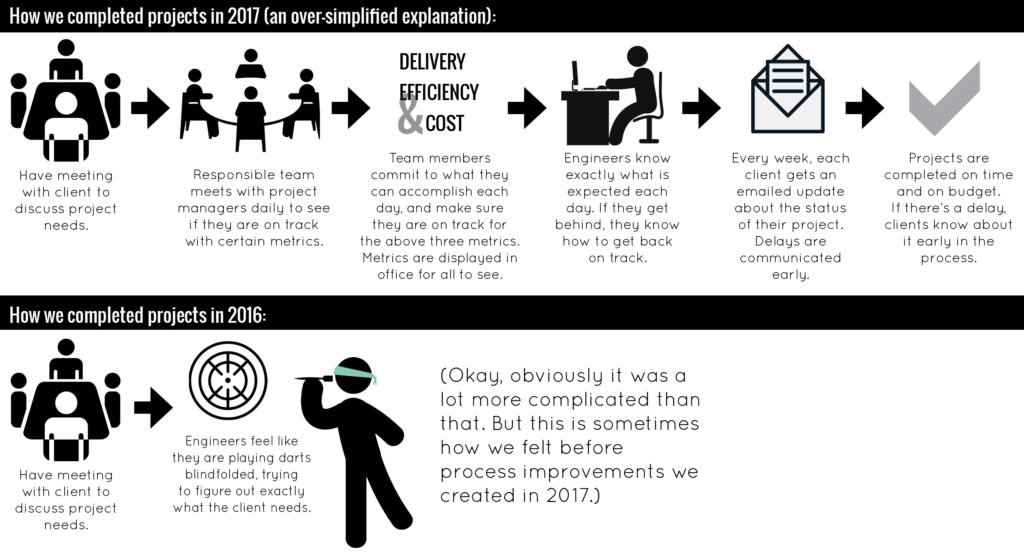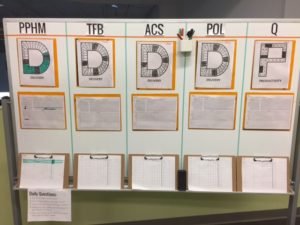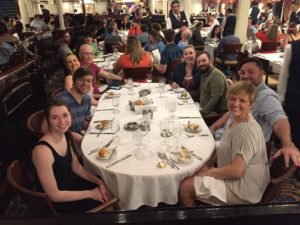Kendra: In case you don’t know us, Jason and I own RoboSource (you can read more about our story here). We’ve also been married for 18 years. Being both spouses and business partners brings some unique challenges… but that’s another post for another day.
Today, we thought we’d write about the lessons we learned in 2017.
Jason: Really, Kendra didn’t give me a lot of choice. Writing this blog went right on my task list.
K: And when the beginning of 2018 brought crazy busyness to Jason’s schedule, I volunteered to co-author. So here we are, writing our first blog post together.
First, here’s a very brief overview of our past two years:
2016 – An exciting year of growth. We started the year with five full-time employees and ended the year with 22. It was a wild, exciting ride.
2017 – We’ve been calling it “The Year We Learned How to Stop Acting Like a Start-Up and Start Being a Small Business.” We spent the year putting out fires, figuring out how to do things better, and finding the right roles for the right people. And in the meantime? Learning, learning, learning.
Man, we learned a lot.
J: Whoa. That sounds pessimistic. I mean, we also had 30% growth in bottom-line revenue last year! Sure, the year had challenges, but overall, it was a really strong year.
K: That’s what I said: we learned a lot! Learning IS growing.
Anyway, back to what we’ve learned. Probably, these are lessons that a lot of start-ups learn in the first few years. But we figured we would share them anyway. Hey, if you can learn from our mistakes, all the better.
Don’t go it alone. Find a group of people to help carry the load.
K: I think our original logic worked – when you are starting a company, it makes sense to just make all the decisions yourself. It gives you the ability to move quickly and make fast pivots. Of course, you ask employees for their opinions, but generally, everyone is running around, trying to keep all the balls in the air. They are just grateful that someone is taking care of things.
J: When you have five employees, that works. It’s easy to grab lunch with everyone and keep them up-to-date on what’s happening. Individual conversations are practical. It makes sense in the early years.
K: But when the growth years hit, having a leadership team in so important.
J: Last spring, I became convinced that we needed to solidify our Leadership Team. It was really just a formality – we already had our go-to people, and we knew who our company leaders were. But it was time to start meeting regularly and letting everyone speak into key decisions.
K: We did one really interesting thing when we officially formed the team. We put all of the “obvious” people on the team of course, but we decided to also have a quarterly floating team member. This could be anyone in the company, likely based on what kinds of things we would be deciding that quarter. This person would become a member of the team in every way – voting, giving opinions, and being held to action items. It’s worked out really well so far.
J: The team meets monthly to keep on top of finances, projects, and to do some bigger-picture strategizing. Together, we came up with new Core Values for the company (more about that later), and we are working to provide further clarity for the company at large. But we also solve problems that arise and brainstorm solutions.
K: But by far the best thing about the Leadership Team? Sharing the load has been SUCH A RELIEF!
Owning a small business is stressful. Being responsible for 24 individuals and families? That’s a whole wad of stress that eats at you day and night. It was incredibly freeing to let a trusted team in on to the roller coaster of both exciting pie-in-the-sky possibilities and immeasurable stress.
J: That’s a little dramatic for my taste. But yes, entrepreneurship can be stressful. It’s been great to have other people take ownership of the company and share that stress.
K: Hands down the best thing we did this year, and we did a lot of great things. My advice? If you own a business, create a board of trusted employees. Do it now. It will help you sleep at night. And you will gain so much from their ideas and insight. We are just plain better together. That’s all there is to it.
Clients can be your best friend … or your worst enemy.
J: I’ve always run RoboSource like the local company it is. Our clients, for the most part, are also our neighbors here in central Indiana. When people say they’ll pay us, I believe them. If our lawyers would let us get by with it, I’d solidify each deal with a handshake. That’s just how I like to operate: I’ll treat you right and expect you to do the same.
K: And that works 90% of the time. Most of our clients are great people. If they say they’ll pay, they pay. If they change their minds halfway through a custom project, they are reasonable people who understand that the cost will go up, since the engineers will need more hours to make the changes. We can treat them like members of our team, and it works. Many of them give us hugs when they walk in the door. We know about their kids’ sicknesses and where they’re heading on vacation, and we actually care. That’s the beauty of working with a small company.
And then there are the 10%. We ran into a few not-so-great clients this year. And we learned that there are some people who just won’t be happy, no matter what.
J: This is really hard for me especially. As a small, local business, our reputation is everything. My natural inclination is to protect it at all costs. That’s the right decision, but some people will take advantage of that. It’s hard to swallow when your first goal is to make every client happy.
K: That’s been a big lesson this year: we can’t make everyone happy. And when people aren’t reasonable, we’ve had to learn how to stick up for ourselves. For a lot of people, this probably comes naturally. I sure wish it did for us. Since it doesn’t, we’ve learned some not-so-fun lessons, like what things a lawyer can do and when it’s not worth it and when to buckle down and when to give grace. There’s no perfect equation to it, but we’re getting better. After this year, we’re a little more cynical, but I think we’re stronger because of it.
Here’s what I say: we’ve been burned, but we’ve learned.
J: (laughs and rolls eyes)
Holding people accountable lets them rise to the occasion, rather than feeling like a noose around their necks.
J: Our theme of the year turned out to be accountability. Early in 2017, I was really feeling the need to move forward with a daily system for holding employees accountable at every level. The idea was that by providing clarity and accountability, they would be able to lead projects, even from a young age. Our strategy consultant was planning to help us with this later in the year, but I asked him to move it up. I just knew it was going to be key to taking us to the next level.
K: I made this graphic to show the changes between the two years. Drastic, huh?
 J: There’s some truth there, but I still kind of hate that. After all, the way we were doing things before is pretty much how all custom software companies do them. It was industry standard – we just believed there was a better way.
J: There’s some truth there, but I still kind of hate that. After all, the way we were doing things before is pretty much how all custom software companies do them. It was industry standard – we just believed there was a better way.
K: True. The way we were doing things in 2016 worked for us for several years. And the graphic isn’t meant to belittle that. But you were absolutely right – there was a better way. Seven months later, we’re still refining the process and rounding off the rough spots, but it has made an incredible difference.

Our first DLA boards.
J: What we learned from implementing Daily Layered Accountability (DLA) is that setting out clear expectations and holding people to them opens the door to individual and team success. In 2016, we had a senior developer overseeing every project, which meant that they were stretched thin and weren’t able to focus in on any one thing. In 2017, teams were self-led. Senior developers were used more for advice and high-level architecture decisions, not for the day-to-day.
K: That adds up to a cost savings for our clients, too.
J: It does. We now have younger engineers leading many projects. And they are excelling at it. There’s a sense of accomplishment and responsibility that we just didn’t have before. Accountability works.
Rely on experts … but don’t follow them off a cliff.
K: When we experienced the astronomical growth in 2016, Jason and I quickly realized that we there was a lot we had yet to learn. So we contracted with expert advisors in several areas, including sales, human resources, recruiting, strategy, marketing, and finance.
J: I would recommend this to anyone. These advisors have been critical in helping us bridge the gap from start-up phase to small-business phase. When your company is very small, you can do those things yourself. But as you grow, you absolutely need training in certain areas. You need an expert to meet with you once a month to look into finances of the past and future months. We’re talking about things like current ratio, debt-to-worth, and working capital. Not numbers you need to understand in the very early days. But they become important quickly.
K: The advisors have been great. But we’ve also learned that we know more than we think we know. In my area in particular, we paid a decent amount of money for two different HR advisors – one to do an audit of the company for compliance issues and another for general advising. Neither unveiled anything we needed to change. By following our gut (and some strategic Google searching), we were already doing pretty much everything we needed to do. We also used a recruiting company to hire a handful of employees and realized that this is something we should continue to do ourselves. We tend to hire best through word-of-mouth and networking rather than through blanket searching. These were all costly mistakes.
My advice: without a doubt, get advisors. But give yourself credit and follow your gut.
K: So that’s some of what we learned in 2017. Years of exponential learning aren’t as much fun as years of exponential growth, but they are probably even more important in the long run.
2017, we won’t miss you, but we know we needed you. Here’s to 2018!
J: You know me, I’m always looking to the future. But I also am able to look back and appreciate what I’ve gained from 2017. Let’s share some of the exciting things we did this year, too.
K: Already on it.
2017: Highlights
1. We had our best summer yet with our RoboSource apprentices. From our original kick-off days to the sand volleyball team we formed, we enjoyed these students completely, and we’re excited to welcome three of them back next summer. Every year, we are getting better at training the students to be able to complete complicated software engineering work independently. It’s never been about the quality of students – these are smart kids, and they’ve always been able to handle the work. It’s been about figuring out how to teach students, who are used to education, how to work in a professional software company. This year, we nailed it.

Dinner on our cruise – so swanky!
3. Last January, we took an all-company (plus spouses) cruise to the Caribbean. We wanted to reward our employees for a great year. What better way to do that than to let them relax and be pampered for a few days? The unexpected benefit was how much everyone bonded. It was so great to walk around the ship and see groups playing cards, participating in trivia, and eating meals together. But RoboSource attracts that kind of employee, and we care about each other. It’s not surprising everyone enjoyed being together so much.
2. This fall, we had our biggest class yet of apprentice applications – 80 students! Due to that volume, we were able to put together a truly shockingly strong class of seven new students that will be joining us in May. We can’t wait to introduce you to them. You will want these students working on your software.
3. We hired six new full-time staff members. They run the gamut from marketing to quality assurance to sales to software engineers (of course!). One of them worked for us as an apprentice during school, so having him here is like the good ol’ days. We made some really great hires this year.
4. We adopted new Core Values that the company is really rallying around. They were one of the first things our Leadership Team did together, and they really represented who we are and why that’s important. The values are making a difference in how we make decisions, how we act, and who we hire.
5. We had a myriad of silly events, roaring laughter, relationships built, and memories made. From celebrating little-known holidays (like National Homemade Bread Day) to family picnics at the park to birthday sashes and culture monkeys, there was so much good about this year.

Recent Comments